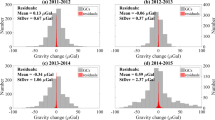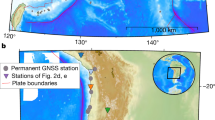Abstract
Understanding how and when far-field continuous motions lead to giant subduction earthquakes remains a challenge. An important limitation comes from an incomplete description of aseismic mass fluxes at depth along plate boundaries. Here we analyse Earth’s gravity field variations derived from GRACE satellite data in a wide space-time domain surrounding the Mw 9.0 2011 Tohoku-Oki earthquake. We show that this earthquake is the extreme expression of initially silent deformation migrating from depth to the surface across the entire subduction system. Our analysis indeed reveals large-scale gravity and mass changes throughout three tectonic plates and connected slabs, starting a few months before March 2011. Before the Tohoku-Oki earthquake rupture, the gravity variations can be explained by aseismic extension of the Pacific plate slab at mid-upper mantle depth, concomitant with increasing seismicity in the shallower slab. For more than two years after the rupture, the deformation propagated far into the Pacific and Philippine Sea plate interiors, suggesting that subduction accelerated along 2,000 km of the plate boundaries in March 2011. This gravitational image of the earthquake’s long-term dynamics provides unique information on deep and crustal processes over intermediate timescales, which could be used in seismic hazard assessment.
This is a preview of subscription content, access via your institution
Access options
Access Nature and 54 other Nature Portfolio journals
Get Nature+, our best-value online-access subscription
$29.99 / 30 days
cancel any time
Subscribe to this journal
Receive 12 print issues and online access
$259.00 per year
only $21.58 per issue
Buy this article
- Purchase on Springer Link
- Instant access to full article PDF
Prices may be subject to local taxes which are calculated during checkout





Similar content being viewed by others
References
Conrad, C., Bilek, S. & Lithgow-Bertelloni, C. Great earthquakes and slab pull: interaction between seismic coupling and plate–slab coupling. Earth Planet. Sci. Lett. 218, 109–122 (2004).
Stein, S. & Okal, E. Ultralong period seismic study of the December 2004 Indian Ocean earthquake and implications for regional tectonics and the subduction process. Bull. Seis. Soc. Am. 97, S279–S295 (2007).
Scholz, C. H. & Campos, J. The seismic coupling of subduction zones revisited. J. Geophys. Res. 117, B05310 (2012).
Hirose, H., Hirahara, K., Kimata, F., Fujii, N. & Miyazaki, S. A slow thrust slip event following the two 1996 Hyuganada earthquakes beneath the Bungo Channel, southwest Japan. Geophys. Res. Lett. 26, 3237–3240 (1999).
Dragerts, H., Wang, K. & James, T. S. A silent slip event on the deeper Cascadia subduction interface. Science 292, 1525–1528 (2001).
Mogi, K. Deep seismic activities preceding the three large ‘shallow’ earthquakes off south-east Hokkaido, Japan—the 2003 Tokachi-oki earthquake, the 1993 Kushiro-oki earthquake and the 1952 Tokachi-oki earthquake. Earth Planets Space 56, 353–357 (2004).
Montagner, J.-P. et al. Prompt gravity signal induced by the 2011 Tohoku-Oki earthquake. Nat. Commun. 7, 13349–13355 (2016).
Vallée, M. et al. Observations and modeling of the elastogravity signals preceding direct seismic waves. Science 358, 1164–1168 (2017).
Tapley, B., Bettadpur, S., Ries, J., Thompson, P. F. & Watkins, M. GRACE measurements of mass variability in the Earth system. Science 305, 503–505 (2004).
Matsuo, K. & Heki, K. Coseismic gravity changes of the 2011 Tohoku-oki earthquake from satellite gravimetry. Geophys. Res. Lett. 38, L00G12 (2011).
Wang, L., Shum, C. K., Simons, F. J., Tapley, B. & Dai, C. Coseismic and postseismic deformation of the 2011 Tohoku-oki earthquake constrained by GRACE gravimetry. Geophys. Res. Lett. 39, L07301 (2012).
Cambiotti, G. & Sabadini, R. Gravitational seismology retrieving Centroid-Moment-Tensor solution of the 2011 Tohoku earthquake. J. Geophys. Res. 118, 183–194 (2013).
Fuchs, M., Bouman, J., Broerse, T., Visser, P. & Vermeersen, B. Observing coseismic gravity change from the Japan Tohoku-Oki 2011 earthquake with GOCE gravity gradiometry. J. Geophys. Res. 118, 5712–5721 (2013).
Dai, C. et al. Improved constraints on seismic source parameters of the 2011 Tohoku earthquake from GRACE gravity and gravity gradient changes. Geophys. Res. Lett. 41, 1929–1936 (2014).
Tanaka, Y. & Heki, K. Long- and short-term postseismic gravity changes of megathrust earthquakes from satellite gravimetry. Geophys. Res. Lett. 41, 5451–5456 (2014).
Han, S.-C., Sauber, J. & Pollitz, F. Broadscale postseismic gravity change following the 2011 Tohoku-oki earthquake and implication for deformation by visco-elastic relaxation and afterslip. Geophys. Res. Lett. 41, 5797–5805 (2014).
Bruinsma, S., Lemoine, J.-M., Biancale, R. & Valès, N. CNES/GRGS 10-day gravity field models (release 2) and their evaluation. Adv. Space Res. 45, 587–601 (2010).
Bouchon, M. et al. Potential slab deformation and plunge prior to the Tohoku, Iquique and Maule earthquakes. Nat. Geosci. 9, 380–383 (2016).
Billen, M. Slab dynamics in the transition zone. Phys. Earth Planet. Int. 183, 296–308 (2010).
Yamaoka, K., Fukao, Y. & Kumazawa, M. Spherical shell tectonics: effects of sphericity and inextensibility on the geometry of the descending lithosphere. Rev. Geophys. 24, 27–53 (1986).
Obayashi, M., Yoshimitsu, J. & Fukao, Y. Tearing of stagnant slab. Science 324, 1173–1175 (2009).
Astiz, L., Lay, T. & Kanamori, H. Large intermediate-depth earthquakes and the subduction process. Phys. Earth Planet. Inter. 53, 80–166 (1988).
Fukao, Y. & Obayashi, M. Subducted slabs stagnant above, penetrating through, and trapped below the 660 km discontinuity. J. Geophys. Res. 118, 5920–5938 (2013).
Taira, A. Tectonic evolution of the Japanese islands arc system. Annu. Rev. Earth Planet. Sci. 29, 109–134 (2001).
Ozawa, S. et al. Preceding, coseismic and postseismic slips of the 2011 Tohoku earthquake, Japan. J. Geophys. Res. 117, B07404 (2012).
Mavrommatis, A., Segall, P. & Johnson, K. A decadal-scale deformation transient prior to the 2011 M w 9.0 Tohoku-oki earthquake. Geophys. Res. Lett. 41, 4486–4494 (2014).
Yokota, Y. & Koketsu, K. A very long-term transient event preceding the 2011 Tohoku earthquake. Nat. Commun. 6, 5934–5938 (2015).
Chen, S. et al. Gravity increase before the 2015 M w 7.8 Nepal earthquake. Geophys. Res. Lett. 43, 111–117 (2016).
Minson, S. E. et al. Bayesian inversion for finite fault earthquake source models – II: the 2011 great Tohoku-oki, Japan earthquake. Geophys. J. Int. 198, 922–940 (2014).
Perfettini, H. & Avouac, J.-P. The seismic cycle in the area of the 2011 M w 9.0 Tohoku-Oki earthquake. J. Geophys. Res. 119, 4469–4515 (2014).
Han, S.-C., Shum, C.-K., Bevis, M., Ji, C. & Kuo, C.-Y. Crustal dilatation observed by GRACE after the 2004 Sumatra-Andaman earthquake. Science 313, 658–662 (2006).
Kawakatsu, H. et al. Seismic evidence for sharp lithosphere-asthenosphere boundaries of oceanic plates. Science 324, 499–502 (2009).
Heki, K. & Mitsui, Y. Accelerated Pacific plate subduction following interplate thrust earthquakes at the Japan trench. Earth Planet. Sci. Lett. 363, 44–49 (2013).
Uchida, N., Asano, Y. & Hasegawa, A. Acceleration of regional plate subduction beneath Kanto, Japan, after the 2011 Tohoku-oki earthquake. Geophys. Res. Lett. 43, 9002–9008 (2016).
Wang, K., Hu, Y. & He, J. Deformation cycles of subduction earthquakes in a visco-elastic Earth. Nature 484, 327–332 (2012).
Pollitz, F., Bürgmann, R. & Banerjee, P. Post-seismic relaxation following the great 2004 Sumatra-Andaman earthquake on a compressible self-gravitating Earth. Geophys. J. Int. 167, 397–420 (2006).
Sun, T. et al. Prevalence of viscoelastic relaxation after the 2011 Tohoku-oki earthquake. Nature 514, 84–87 (2014).
Hasegawa, A. & Yoshida, K. Preceding seismic activity and slow slip events in the source area of the 2011 Mw 9.0 Tohoku-oki earthquake: a review. Geosci. Lett. 2, 6–18 (2015).
Ozawa, S. et al. Coseismic and postseismic slip of the 2011 magnitude-9 Tohoku-Oki earthquake. Nature 475, 373–376 (2011).
Ide, S., Yabe, S. & Tanaka, Y. Earthquake potential revealed by tidal influence on earthquake size–frequency statistics. Nat. Geosci. 9, 834–837 (2016).
Bird, P. An updated digital model of plate boundaries. Geochem. Geophys. Geosyst. 4, 1027–1078 (2003).
Hayes, G. P., Wald, D. J. & Johnson, R. L. Slab1.0: a three-dimensional model of global subduction zone geometries. J. Geophys. Res. 117, B01302 (2012).
Bulletin of the International Seismological Centre (2013); http://www.isc.ac.uk/iscbulletin/search/webservices/bulletin/
Acknowledgements
We thank CNES for financial support through the TOSCA committee. C.N. acknowledges the financial support from the UnivEarthS LabEx programme of Sorbonne Paris Cité (ANR-10-LABX-0023 and ANR-11-IDEX-0005-02). We thank H. Perfettini for providing co-seismic and post-seismic slip distribution models and their predicted surface displacements. We thank G. Métris for providing the software for the differentiation of spherical harmonics, and B. Romanowicz for important comments on the manuscript and the figures. Valuable reviews, including a review by K. Heki, contributed to significantly improve our work. All figures have been made using the GMT software. This is IPGP contribution number 3926.
Author contributions
I.P. designed the four-dimensional gravity analysis and performed all data analyses. S.B., D.R. and I.P. conducted the gravity modelling of earthquake-related signals and wrote the corresponding sections of the Supplementary Information. C.N. conceived the pre-seismic statistical data analysis and the space-time diagram. J-M.L. provided information on the GRACE geoid models. All authors discussed the analyses and their results at all stages. I.P. wrote the manuscript and data analysis sections of the Supplementary Information with input from all co-authors.
Author information
Authors and Affiliations
Corresponding author
Ethics declarations
Competing interests
The authors declare no competing interests.
Additional information
Publisher’s note: Springer Nature remains neutral with regard to jurisdictional claims in published maps and institutional affiliations.
Electronic supplementary material
Supplementary Information
Supplementary Methods, Figures and Tables.
Rights and permissions
About this article
Cite this article
Panet, I., Bonvalot, S., Narteau, C. et al. Migrating pattern of deformation prior to the Tohoku-Oki earthquake revealed by GRACE data. Nature Geosci 11, 367–373 (2018). https://doi.org/10.1038/s41561-018-0099-3
Received:
Accepted:
Published:
Issue Date:
DOI: https://doi.org/10.1038/s41561-018-0099-3
This article is cited by
-
Change of deep subduction seismicity after a large megathrust earthquake
Nature Communications (2024)
-
Cascade and pre-slip models oversimplify the complexity of earthquake preparation in nature
Communications Earth & Environment (2024)
-
Evaluating flood potential in the Mahanadi River Basin, India, using Gravity Recovery and Climate Experiment (GRACE) data and topographic flood susceptibility index under non-stationary framework
Environmental Science and Pollution Research (2024)
-
Gravity field changes reveal deep mass transfer before and after the 2013 Lushan earthquake
Communications Earth & Environment (2023)
-
Applications and Challenges of GRACE and GRACE Follow-On Satellite Gravimetry
Surveys in Geophysics (2022)



